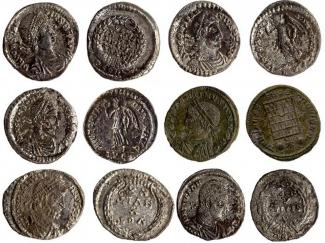Group of coins
Roman, 4th century AD
Found during excavations by Wessex Archaeology at Silchester Place, formerly the Evans Halshaw Garage, Hyde Street, Winchester in the early 2000s
These six coins, five siliquae of silver and one nummus of bronze were found in a pile at the bottom of a soil layer that had developed over derelict Roman buildings in the northern suburb of Roman Winchester. The siliquae date from AD 355-63 and were quite valuable in food purchasing terms- one would have bought about three days' generous rations for a Roman soldier. The nummus is earlier in date- AD 324-30- and worth less, but seems to have been associated with the other coins nevertheless. This small hoard perhaps represents the contents of a lost purse, rather than a savings bank.
Constantine the Great brought Christianity to the Roman empire, divided it into two parts, the eastern and western, and took the imperial court to Constantinople (sometime known as Byzantium and eventually as Istanbul). These coins came from the western mints in Gaul, at Trier, Arles and Lyons. He also tried to reduce tension around the succession by allowing for more than one emperor at the same time, and for successors (Caesars) to be nominated during the lifetimes of the reigning emperors. This did not work, human nature being what it is. Hardly any of his descendants, collectively called the House of Constantine- AD 337-64- ended peacefully in their beds.
The earliest coin in the hoard, the bronze, is of his son Constantine II, Caesar in the west before Constantine the Great's death in AD 337. Four of the other coins are from a time when Constantine II and several successors and usurpers had met sticky ends. Reigning in the east was Constantius II, Constantine II's brother- accounting for three of the silver coins-, whilst a young relative, Julian- accounting for one coin- was upcoming in the west.
The inevitable confrontation between Constantius and Julian was forestalled in AD 361, when Constantius died, and the latest silver coin is of Julian as sole emperor. Julian is famous for being 'apostate' (deserting the faith) as he reversed Constantine the Great's reforms, and gave encouragement to adherents of the old gods. He was killed in AD 363 in an ill-fated campaign against the Persians.



